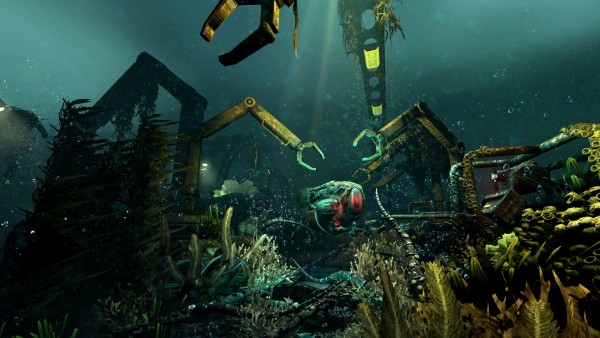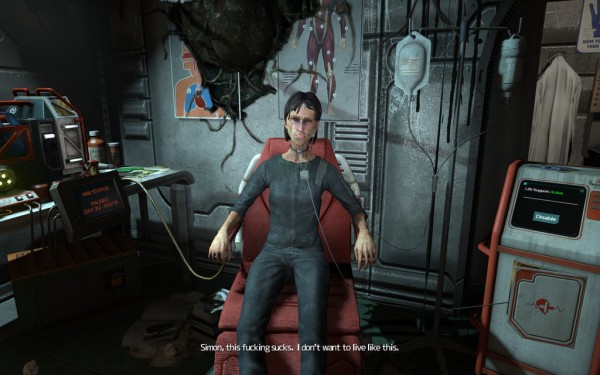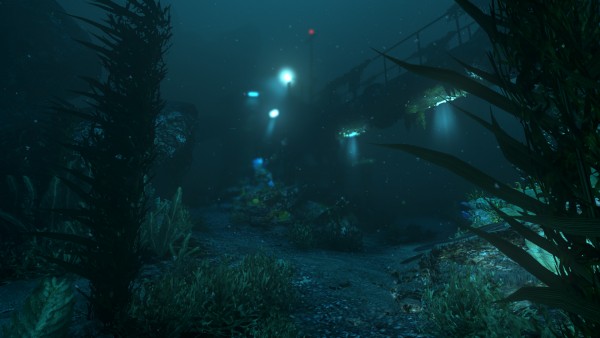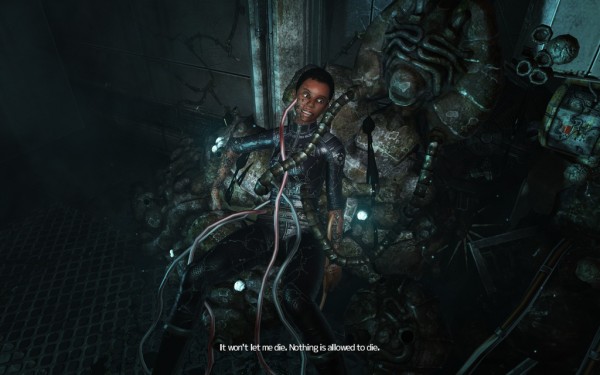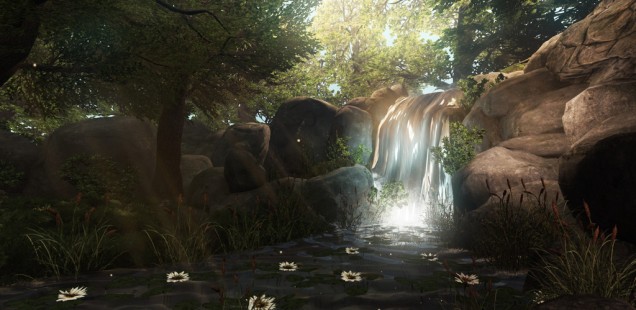
Storyplay: Human Machines
Melody wonders what it means to be human.
Simon: “What will you do when you get into the ARK? What’s the first thing?”
Catherine: “Make sure the ARK is safe, stabilize flight path, activate solar panels—”
Simon: “No, what’s the first human thing you’re gonna do?”
Catherine: “Oh… Watch the clouds roll by? Does that count?”
Simon: “I’d say so.”
(From Frictional Games’ SOMA)
SOMA blurs the line between human and machine, between natural and artificial, and between life and death. It opens with a Gone Home-like section in present-day Toronto. A car accident leaves the protagonist Simon Jarrett seriously hurt, and conventional treatments cannot help save him any longer. He decides to try an experimental treatment: cutting-edge technology is able to scan his brain and not only photograph it but also to capture his unique neural configuration in such a way that a computer can build a working replica. Doctors can try thousands of different therapies on the simulated brain before giving Simon the most appropriate one. Unfortunately the technology is still too rough at this time, and Simon dies.
The setting suddenly shifts to the twenty-second century. Humanity is almost extinct after a comet hits the surface of the earth, completely destroying it. The only survivors are on the underwater research station PATHOS-2, whose systems are failing and running out of resources. They also have to deal with the WAU, or “WArden Unit,” the AI in charge of preserving life in the research station. Normally, the WAU would simply control environmental factors like atmospheric pressure and temperature, but after the surface is destroyed, it starts interpreting its objective in a more aggressive fashion. Without a strong concept of what life is, the WAU starts forcefully keeping people alive as well as making new life out of whatever pieces it can reach. Simon’s brain scan, one of the first ever, has become a common template on which programmers build complex AIs, and the WAU decides to upload it as is onto the machine-augmented body of Imogen Reed, a dead scientist on PATHOS-2.
Soon after finding himself on PATHOS-2, Simon meets Catherine and learns about her ARK project, which will become the objective driving the player forward for the entirety of the game.The ARK is something like an MMO server or the Matrix, but it’s attached to a rocket and some solar panels. The aim is to give humanity a second chance to survive inside the simulation by uploading as many brain scans as possible into the ARK and launching it into space. The people inside the ARK will live on and grow, unable to distinguish the virtual space from reality.
It is in this context that the human-made spaces of SOMA are being reappropriated by two different forces: the sea is slowly eating into the base, and a synthetic substance known as structure gel is doing the same. The structure gel is the lifeblood of PATHOS-2: it can be found inside every wall, spilling out whenever the base is damaged and quickly hardening in contact with the atmosphere. While its original purpose was to automatically fill any holes in case of structural damage, the WAU learned to use this substance truly as its own blood. When Simon arrives at PATHOS-2, the WAU has reprogrammed the gel so that it carries information, and from that point its properties become quasi-magical – it shows an autonomous, almost intelligent capacity to adapt that we normally associate with living tissues rather than dead material.
Both forces manifest in analogous ways, including visually; the structure gel in particular invades and reclaims the decaying research station in a way that echoes our cultural fantasies of abandoned post-apocalyptic cities being reclaimed by nature, or the way the alien of the homonymous saga modifies human-made spaces to create an environment fit for its life and reproduction. The SOMA live-action miniseries says of the gel “It’s like a scab,” calling up images of living bodies. The structure gel forms roots, arms, bulbs, and tentacles that twine in and around rooms, almost manifesting a will of physical possession.
The technology in SOMA is alive at least as much as its natural counterpart, the sea. Humanity finds itself sitting in the middle, losing control over the spaces it has built. Not only the physical spaces: these two forces are intruding upon the conceptual space of what human life is, compelling humanity to redefine what it means to be human.
When Aristotle set out to define what it means to be human, he was looking to differentiate the Greek man, whom he considered the fully developed human, from animals, outsiders, slaves, and women. He determined that man is a “rational animal” given that non-human animals don’t have the kind of rationality and free will that men do. Women have an intellect too, but he believed it was too imperfect, easily clouded, and swayed by emotions and irrationality, so in everyone’s best interest they should keep its use to a minimum. Aristotle saw slaves as non-human tools, able to understand language and follow orders but unable to reason for themselves.
These days, when we talk about being human, we’re more preoccupied with defining humanity in opposition to machines and advanced AIs. We want to reassure ourselves that we have something more than an uncanny android who looks like us, acts like us, speaks like us, and is better than us at almost everything. It’s as if we know our feeling of superiority is dwindling. Taking the Aristotelian definition to its extremes, perhaps we could say that modern-day machines, as purely rational creations, are even more human than us.
In response, we’ve switched our concept of what it means to be human to highlight the irrational, the spiritual, the unconscious, the non-functional, the useless. We praise our defects, our mortality, our fallibility. Our fragility, our idiosyncrasies, our emotions, our heart and soul— we reach for them to define us as human to keep us ahead of technology’s leaps and bounds. If rationality, logic, mathematics, and utilitarian thinking are the domain of machines, then the human is the excess compared to those dimensions. In trying to preserve the core of what it means to be human, it’s easy to forget that this core immediately changed when coming into contact precisely with what we’re defining humanity against. The very existence of machines has already changed our concept of what it means to be human.
However, I feel there’s a strong risk inherent in this kind of thinking. Defining something against its neighboring concepts is often misleading. It may be reassuring, but it’s also exoticitizing: it encourages us to see the differences as the essence, instead of looking at the thing itself in its polyhedral complexity.
We make this mistake all the time because it’s the easiest way to build an identity. With people, we reject the Other based on their uniqueness instead of dwelling on all the things we have in common. In videogame criticism, we often build shrines to interactivity because it’s the only thing setting us apart from cinema and literature. It’s as if games couldn’t make use of the whole range of possibilities that they offer, but had to limit themselves to a small subset (player expression, open worlds, branching storylines, and immersion, to name a few) lest they lose the purity of their identity as games.
This is the risk I see in the differential idea of human that lies at the heart of the quote that opens this article. It’s not that rationality isn’t part of what it means to be human, it’s just that rationality is not unique to us anymore. And that’s fine, because it’s still part of our identity. We invented maths and built technology, but we still like to watch the clouds roll by. I feel like Catherine’s responses to Simon’s question are both wholly human. The first tells us about how she worries and hopes that everything goes well and that she will use her technical knowledge to make sure the ARK project proceeds smoothly. The second tells us about a different side of her personality, no more or less human than the others. Both are fundamental to her overall identity.
If we keep this in mind, if we are careful to not lose this perspective, then we can also keep exploring what is valuable in SOMA, which admittedly is not interested in the concepts of human and machine in themselves, but only in the area where the two blur and overlap. Where does the machine end and the human begin?
The main space where this question is pursued is the body. The word “soma” itself means body “as contrasted with the mind or psyche.” In fact, as the story moves forward from Simon’s original incarnation in Toronto to the ARK project, mind and body grow progressively more disconnected from each other. When Simon first finds out about his new, borrowed body, and then when he has to again copy his consciousness onto a third body, he has a hysterical reaction that, in its violence and rejection of rational discussion, betrays the breaking of an instinctive, deeply-held belief about the sacrality of the body and its importance in defining our overall identity. Against any Cartesian dualism, Simon refuses to even consider that his body may not be a core part of who he is, even though it may be imperfect, weak, inappropriate for the task at hand, and arbitrary insofar as he didn’t even choose his original body— it just happened to him like it happens to all of us.
The human bodies in SOMA are all dying. People on the brink of death are scattered throughout the game, and the WAU, tasked with preserving life, forcibly keeps them alive. They’re in terrible pain, barely conscious. Living doesn’t mean anything to them anymore, but the WAU doesn’t know any better.
Alongside these are other broken bodies: robotic bodies, like the one in the trailer. They too are the result of the WAU’s clumsy attempt to repopulate the station by uploading brain scans meant for the ARK onto whatever piece of hardware could host them. They aren’t aware of themselves, and they refuse to rebuild their identity in accordance with their new hardware. Those who did realize what happened to them went mad and, at least according to several fan theories, are the ones who play the part of the monsters, chasing the player throughout the game.
Simon too is uploaded into Imogen Reed’s body by the WAU. The fact that his new body is in part human is perhaps the only reason why this is the only attempt that half-works. Eventually, the player meets Sarah Lindwall, the last person still surviving in her original body. She is guarding the ARK, humanity’s only hope for a future. In her room, like in most rooms, there are pictures of loved ones and scenes from a world that is no more, but which she can’t let go of. She asks the player to kill her. She knows the WAU wouldn’t ever let her die.
This attachment to the body as an imprescindible part of one’s identity, both in a positive and in a negative way, is one manifestation of that excess that is unique to the human. We also have have Catherine, the exception who accompanies the player for the best part of the game but who lives in a chip attached to Simon’s Omnitool. I don’t think the game explicitly says why she doesn’t go mad like everyone else who suffered a similar fate, but I believe the answer may be found in her strong sense of purpose. She devised the ARK project, and she is determined to see it through to success, a perspective which also gives her hope. I think she’d have gone mad too, given enough time, but for the length of the game she has a very clear objective in front of her, which grounds her identity enough that whatever hardware is OK as long as it’s useful for her cause.
Catherine is the most liminal figure in this world in which every barrier is being broken. A human mind in purely mechanical hardware, she is driven by a very specific purpose, and, like a machine, she evaluates the world purely in terms of utility towards that purpose. But what she wants to achieve is precisely the recovery of a space in which to be human. As such, she is driven by a concept of what human life means as opposed to the mere survival of biological functions, a concept that the WAU never understood.
The machine ends when there is no clear objective left to achieve. The human, as we have seen, begins with the excess: the reality of being left behind when the objective has been achieved and disappears. It’s the reality of being alive when there is nothing left to do, a reality in which the body remains in its irreducible, useless materiality.
Eventually, Simon and Catherine both make it inside the ARK. It’s a breathtaking environment: an idyllic forest, a waterfall, the sunlight peeking through the leaves. The bright, lively colors make for a refreshing contrast compared to the darkness that characterized the rest of the game. There is no decay, no corruption, no menace— just the human ideal of a welcoming space. A place where they can lie down and watch the clouds roll by. It may be a virtual environment, but for all intents and purposes both Simon and Catherine feel like they are really there. And they have their original bodies back.
The game ends with Catherine turning around, her arms open, to welcome Simon. The screen immediately turns black, but I like to think that they share a warm hug. Another useless, human excess.
Melody is passionate about games, words, and music, and she expresses her love by meowing. You can find her on her blog, and on Twitter.
